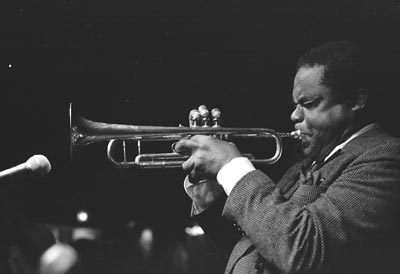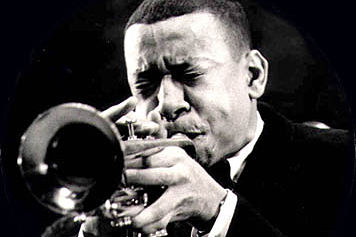FREDDIE HUBBARD / “Pensativa”
Two men. One stage. Two trumpets. One song.
It is a good, old-fashioned cutting contest. Or so it seems. Both men are playing with passion, intensity and an honest intention of one blowing the other off the stage. The audience is obviously hyped. You can hear them cheering. Hear them egging on the musical confrontation. Hearing them delighted to be present at ringside.
The song is “Pensativa,” a Claire Fischer composition in the bossa nova style that was current in the sixties. Generally, a more uptempo blues or a standard-based song is preferred for a cutting contest but in this case “Pensativa” works just fine.
After the opening solos (Lee Morgan is playing with a mute in the beginning) and a brief Harold Mabern Jr. piano solo the gladiatorial contest commences in earnest.
 Freddie, virtuosic with rapid runs and high notes.
Lee, deceptively brilliant with grace notes and half-valve effects.
Cobra, mongoose.
Who wins? We all do.
Freddie, virtuosic with rapid runs and high notes.
Lee, deceptively brilliant with grace notes and half-valve effects.
Cobra, mongoose.
Who wins? We all do.
 Born July 10, 1938 in Philadelphia, Lee Morgan started out as a youthful disciple of Dizzy Gillespie. Dizzy hired Morgan to play in his big band when Morgan was just 18 years old. By 1956 Lee Morgan was recording as a leader. He went on to record over 25 albums on the influential Blue Note label. In 1958 he achieved worldwide acclaim when he joined Art Blakey’s Jazz Messengers. When he left the Messengers, Morgan urged Blakey to hire a young Freddie Hubbard as Morgan’s replacement.
Although Morgan was very popular, drugs negatively affected his career and by the early sixties he was missing in action on the national jazz scene. Morgan moved back home to Philly to get himself together. By 1964 he had returned to the scene and had a major hit with “Sidewinder,” which set the standard for the pop-influenced, boogaloo jazz movement that was a hallmark of the Blue Note recordings of that period.
Drugs re-entered Morgan’s life and once again his up and down career careened out of control. Some say he was briefly homeless, sleeping on pool tables. Others say he hocked his horn. But by July 1971 when he recorded Live At The Lighthouse (in Hermosa Beach, California) Lee Morgan’s career was once again on the upswing both professionally and personally. Morgan was playing strong as ever and with the help of his girlfriend Helen Moore, Morgan had gotten himself together.
On February 19, 1972 at the age of 33 Lee Morgan was killed. He had an argument between sets with Ms. Moore. The argument led to an altercation during which Morgan’s gun went off. Moore had the gun in her overcoat. At Morgan’s direction she had brought the gun to the club to give to him because of an unrelated conflict Morgan had with an alleged drug dealer. When Moore walked in the club, Lee Morgan was talking with another. A rival.
Jazz is full of such legends. But back to the recording at hand. The club gig was during a low point in Morgan’s life. It was a Freddie Hubbard session for Blue Note. The session was recorded at Club La Marchal in Brooklyn, New York. Freddie invited Lee Morgan to sit in on the session. The offer was a sincere effort by the younger man to help someone who had opened doors for him.
What we hear is not the enmity of combat but rather the playful but nonetheless forceful rivalry of siblings. A younger brother who is doing well looking out for an older brother whose career is at a nadir.
Even though it is a cutting contest (neither is going to take it easy on the other), no one is bleeding. Each plays mightily. Each note is heartfelt. These men love each other. Embrace each other in sound.
“Pensativa.” Think about it. Listen to it again. The song. The emotion. The spirit. It’s beautiful.
—Kalamu ya Salaam
Their methods are a little different
This cutting contest is helped along by how similar Morgan and Hubbard sound. To me, their tones are virtually identical, but their methods are a little different. One plays longer, slightly sweeter phrases while the other has a more powerful but noticeably choppier style. At first, I thought the former was Hubbard and the latter Morgan, but when I listened to the whole thing again, I wasn't so sure. Then I took a quick listen to Hubbard's solo on "Red Clay" and decided it was Hubbard with the stronger but choppier style and Morgan who plays long and sweet. I can't honestly say I'm sure about that theory either, but I'm sticking with it for now. In any case, these two can both really blow. Obviously.
—Mtume ya Salaam
Born July 10, 1938 in Philadelphia, Lee Morgan started out as a youthful disciple of Dizzy Gillespie. Dizzy hired Morgan to play in his big band when Morgan was just 18 years old. By 1956 Lee Morgan was recording as a leader. He went on to record over 25 albums on the influential Blue Note label. In 1958 he achieved worldwide acclaim when he joined Art Blakey’s Jazz Messengers. When he left the Messengers, Morgan urged Blakey to hire a young Freddie Hubbard as Morgan’s replacement.
Although Morgan was very popular, drugs negatively affected his career and by the early sixties he was missing in action on the national jazz scene. Morgan moved back home to Philly to get himself together. By 1964 he had returned to the scene and had a major hit with “Sidewinder,” which set the standard for the pop-influenced, boogaloo jazz movement that was a hallmark of the Blue Note recordings of that period.
Drugs re-entered Morgan’s life and once again his up and down career careened out of control. Some say he was briefly homeless, sleeping on pool tables. Others say he hocked his horn. But by July 1971 when he recorded Live At The Lighthouse (in Hermosa Beach, California) Lee Morgan’s career was once again on the upswing both professionally and personally. Morgan was playing strong as ever and with the help of his girlfriend Helen Moore, Morgan had gotten himself together.
On February 19, 1972 at the age of 33 Lee Morgan was killed. He had an argument between sets with Ms. Moore. The argument led to an altercation during which Morgan’s gun went off. Moore had the gun in her overcoat. At Morgan’s direction she had brought the gun to the club to give to him because of an unrelated conflict Morgan had with an alleged drug dealer. When Moore walked in the club, Lee Morgan was talking with another. A rival.
Jazz is full of such legends. But back to the recording at hand. The club gig was during a low point in Morgan’s life. It was a Freddie Hubbard session for Blue Note. The session was recorded at Club La Marchal in Brooklyn, New York. Freddie invited Lee Morgan to sit in on the session. The offer was a sincere effort by the younger man to help someone who had opened doors for him.
What we hear is not the enmity of combat but rather the playful but nonetheless forceful rivalry of siblings. A younger brother who is doing well looking out for an older brother whose career is at a nadir.
Even though it is a cutting contest (neither is going to take it easy on the other), no one is bleeding. Each plays mightily. Each note is heartfelt. These men love each other. Embrace each other in sound.
“Pensativa.” Think about it. Listen to it again. The song. The emotion. The spirit. It’s beautiful.
—Kalamu ya Salaam
Their methods are a little different
This cutting contest is helped along by how similar Morgan and Hubbard sound. To me, their tones are virtually identical, but their methods are a little different. One plays longer, slightly sweeter phrases while the other has a more powerful but noticeably choppier style. At first, I thought the former was Hubbard and the latter Morgan, but when I listened to the whole thing again, I wasn't so sure. Then I took a quick listen to Hubbard's solo on "Red Clay" and decided it was Hubbard with the stronger but choppier style and Morgan who plays long and sweet. I can't honestly say I'm sure about that theory either, but I'm sticking with it for now. In any case, these two can both really blow. Obviously.
—Mtume ya Salaam
This entry was posted on Monday, January 28th, 2008 at 8:11 am and is filed under Classic. You can follow any responses to this entry through the RSS 2.0 feed. You can leave a response, or trackback from your own site.
3 Responses to “FREDDIE HUBBARD / “Pensativa””
March 19th, 2008 at 4:25 am
Great post sir, ¡and what a great song!. In fact I wrote a post in my blog about this song just 3 days ago (sorry, in spanish). I was talking about the difficult to known who is playing when the “trumpet war” begins, and, I agree with your opinnion: nobody loses, we win.
best regards
Erradizo
March 28th, 2008 at 11:08 pm
Nice article on one of the greatest jazz trumpet happenings ever. To have been there that night would have been awesome. Both Freddie and Lee were amazing. I had the pleasure of meeting Freddie once backstage at one of his performances. I asked him “tell me about Lee Morgan”. His reply, “Lee was a crazy motherfucker man, crazy motherfucker”.
November 16th, 2009 at 1:36 am
HI! Interesting info. One fact is that Freddie Hubbard was slightly older than Lee Morgan, by just months. In fact, in the Year 1938, it was a great year for Trumpeters. There were 3 Great Trumpeters born within the first 7 months of that year: Booker Little; Freddie Hubbard; and Lee Morgan. It doesn’t get any better than that.
Leave a Reply
| top |